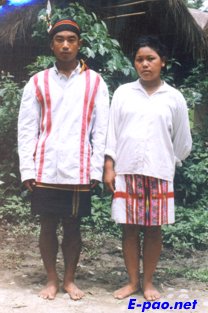|
The Vaiphei tribe, which falls under Mongoloid stock, is a scheduled tribe of Manipur. Their population was
recorded as 16245 in the 1981 census report of the Government of India. The belief that the ancestors of
the Vaipheis emerged out of Khul (cave) exists among the Vaipheis.
It is said that when the Thibom dynasty of Mandalay became powerful and began to subjugate smaller communities
, the Vaipheis left their settlement site in fear. They moved to a place near the Ningthi river
called Kalemeyo and then to Saijang. From Saijang they moved to Chimniy and Khosak respectively.
From Khosak they move to Ngatam lui and there they were divided into Sijang and Vaiphei.
Vaiphei group from there went towards the Chin Hills and settled at Phaiza.
This group further moved themseleves to Kamhou and from there they began to enter the south eastern hilly regions
of Manipur around 1891 A.D. Today the Vaipheis are found to have mainly concentrated in the Churachandpur district of Manipur.
 The Vaipheis speaks the Kuki-Chin group of language. Their society is patraical and patronymic. The kinship
structure is of classification type and one kinship term is used for different categories of relatives.
The Vaipheis speaks the Kuki-Chin group of language. Their society is patraical and patronymic. The kinship
structure is of classification type and one kinship term is used for different categories of relatives.
The tribe is divided into a number of clans and sub clans. The clans are endogamous though inter clan
marriage is not uncommon. Many Vaipheis are confused about the exact number of their clan. Each clan has
its head called 'Upa'. Eldest son inherits his father.
Their main occupation, agriculture, is practiced through both types of cultivation - shifting and wet
cultivation.
Among them, there exists a system of community and social obligations under the term and
conditions of Tawmngaihna and Kihutuana which means the services rendered to others in times of need or in
other words, solidarity of the village in every moments of joy, sorrow or calamity.
Every Vaiphei village has a legitimate chief called Khawpa or Haosa, which is a hereditary post. He is
assisted by Siamang Pachaeng (Ministers, nobles or elder). Taangsampu is the village crier, informing the
entire village in any matter.
Thiik-Seekpu (Blacksmith), Tunpu (hunting commander) also command
respect from the villagers. Every dispute is tried in the Innpi-Vaihawn (village court)
by the Chief and the nobles.
For an individual born in the Vaiphei soceity, he/she is welcome through a function called Naoyuneck when
the pregnant mother is about seven or eight months due. The birth ceremony of a child is held on the
seventh day of the child by entertaining the villagers.
Children whether male or female, get their
earlobes pierced with a tough hair of Saku (an animal) and black & red thread. Marriage is by engagement or
negotion.
The prescribed mate for a boy is the daughter of his maternal uncle. Pre marital sex is
considered a disgraceful act and if the boy refuses to marry the girl, he is imposed to fine with one mithun
and one pig.
Death ceremony of a child under six months is not necessary. Otherwise dead is buried with
the head turning towards the east. Cooked spleen of cattle considered to be the food of the deceased is
also buried along with the corpse.
The traditional religion of Vaipheis is animism. Amorphous deities and spirits are responsible for
benevolent and malevolent effects. The supreme deity is Pathian.
They also believed in manna-like powers, which in their dialect is known as Bulung and possessor of it enables him to have a good harvest. Theirs have a family deity known as Dawibawm.
From around 1907 A.D. under the Welsh Mission the conversion of Vaipheis to Christianity took place. It
made them to ignore it's traditional festivals.
The important traditional festivals include Thazinglam, a
dead festival. Sa-ai (hunting), Oa ai (fishing), Bu-ai (harvest), Somzu (for dormitory) and lom zu (group
organization).
Sometimes a rich person can celebrate some sort of 'feast of merit' involving combined
celebration of Sa-ai and Bu-ai lasting for at least a week.
Manindra Konsam from Sanathong wrote this article.
|